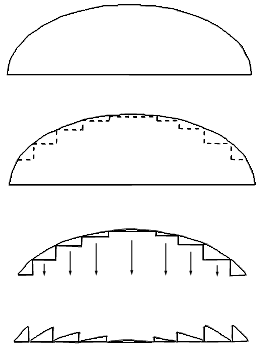
de Buffon cut away the inside of the lens and left rings with edges on the outside. Later, Augustin Fresnel modified this idea and the modern Fresnel lens was created. His lenses were first used on the French coast as a lightweight and less-expensive alternative to the old, bulky lighthouse lenses.
Below is a schematic cut-away diagram showing how a Fresnel lens is
made.

Fresnel lenses are lighter than conventional convex lenses. The Fresnel
lens can have the same focal length as a conventional lens so both can
have the same magnification. The image quality is not as good in the Fresnel
lens as in the conventional lens. When plastic is used as is the case
for the Fresnel lens in the Optics Kit, the quality of the image is further
degraded over that of a quartz lens.
Page authored by the
ACEPT W3 Group
Department of Physics and Astronomy, Arizona State University, Tempe, AZ 85287-1504
Copyright © 1995-2000 Arizona Board of Regents. All rights reserved.